Terms Every Cigar Smoker Should Know

Smoking a cigar can be intimidating, from figuring out what to choose to how to cut and light your first few smokes and then properly storing them. Thankfully, if you've been reading our handy guides on the Daily Reader, you should be armed with the knowledge to get going. However, you may have encountered some terms and phrases while reading that left you thinking what even is a vitola? Or as you're browsing our video content, you may hear Tyler Caldwell referring to what could only be assumed is a fashion-fad-turned-weather pattern from the 1970s (I mean, really, what do they mean by retrohale?) No need to worry. This comprehensive list is here to help alleviate some stressors in anyone's growing pains. Check out some of the industry-specific terms we believe every cigar smoker should know.
List of Cigar Terms
Cigar Components
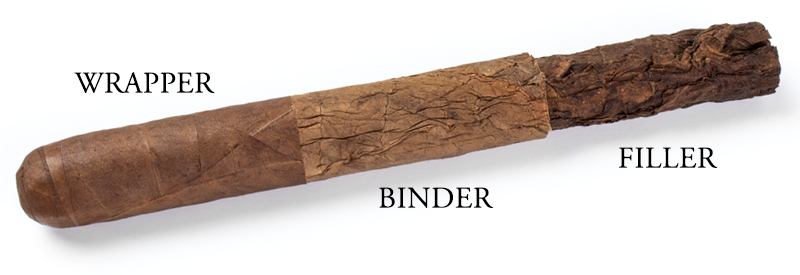
Wrapper
The outermost layer of a cigar, this high-quality leaf is typically free of any cosmetic imperfections. This is the part of a cigar we see from the outside. The wrapper is utilized to cover the filler and binder, to draw the smoker in with its appearance, and to provide lots of flavor in the smoke.
The following are versions of wrappers that can be used in cigars:
Connecticut Broadleaf, Pennsylvania Broadleaf, Mexican San Andrés, San Andrés Oscuro, Sumatran, Sun Grown, Candela, Cameroonian, Nicaraguan, Indonesian, Honduran, Habano, Ecuador Sumatra, Connecticut, Habano, Ecuadorian, Dominican, Criollo, Corojo, Connecticut Shade, Connecticut Habano, and Brazilian. Additionally, Double Claro (Candela), Claro, Colorado Claro, Colorado, Colorado Maduro, Maduro, and Oscuro leaves, with their own unique shades and processes that prepare them for use as wrappers.
Example: A hybrid Connecticut Shade and Brazilian Mata Fina wrapper covers the binder and filler tobaccos, affording delectable flavors in Caldwell's Eastern Standard Sun Grown.
Binder
This leaf keeps the filler contained, also assisting in maintaining a consistent burn when lit.
Example: Caldwell's Eastern Standard Sun Grown cigar features an Ecuadorian binder over fillers from Mexico and the Dominican Republic.
Filler
These tobacco leaves make up the inner part of a cigar, which is covered by the binder and wrapper. Filler can be short or long, depending on the type of cigar, and can often be several different tobacco leaves combined.
Example: Caldwell's Eastern Standard Sun Grown features filler tobaccos from Mexico and the Dominican Republic, offering rich notes of spice and earth.
For more information on cigar components, check out this article on cigar anatomy.
Cigar Parts

Cigar Cap
A piece of wrapper leaf that is placed at the top of a cigar to secure the wrapper. Some examples of cigar caps include single, double, or triple, torpedo, or pigtail cigar caps.
Example: The Neaderthal from RoMa Craft features a flat cigar cap, which can be punched with a cutter before enjoying the smoke.
Cigar Foot
This is the end of the cigar that you light. It is typically open, though some handmade cigars have closed feet.
Example: When lighting a cigar, be sure to light the cigar foot to ensure a smooth smoking experience.
For a more in-depth look into cigar parts, check out our post on cigar anatomy.
Cigar Cuts
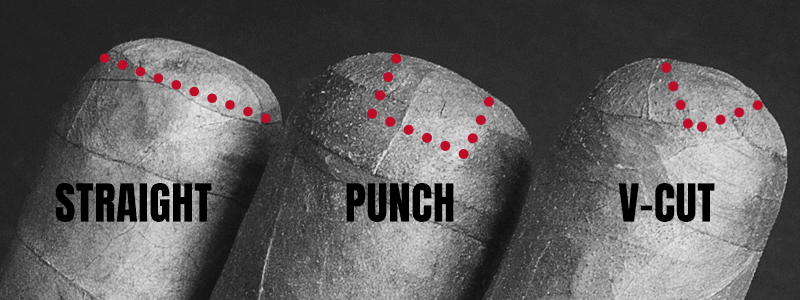
Straight Cut
A smooth cut across the head of the cigar, also known as a guillotine cut made with one or two sharp blades.
Example: Typically straight cuts are used for cigars with a rounded cap.
Punch Cut
A punch tool is utilized to achieve this cut, with a sharp point at one end to create a small hole.
Example: Punch cuts are best for cigars with thicker wrappers and on standard shapes.
V-Cut
This cut is a cross between a guillotine cutter and a punch cut, removing a smaller amount from the head. A v-shaped notch is cut with a v-shaped blade.
Example: A v-cut works the best on smaller cigars with thinner wrappers.
For more on how to cut a cigar, check out our guide.
Cigar Shapes/Sizes
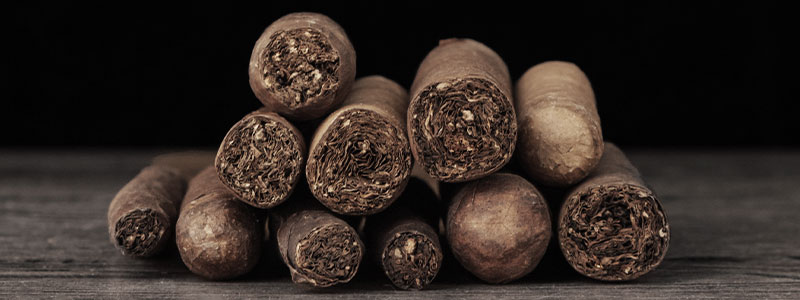
Vitola (vih-toh-la)
This is another word for a cigar's shape, size, and dimensions. Deriving from Spanish, common examples of vitolas include Robusto and Toro.
Example: An assortment of tasty cigars is available on-site in an array of vitolas, including Churchill and Belicoso sizes.
Ring Gauge
Cigar widths are measured in 64ths of an inch, similar to how wedding rings are fitted, by diameter.
Example: Eastern Standard Sungrown Toro Extra has a ring gauge of 54/64, making the measurements 6" x 54 in this particular vitola.
Figurados
These cigars are not straight-sided, but rather are cylindrical in shape.
Example: Figurados cigars include the Pyramid, Belicoso, Torpedo, Perfecto, Culebra, and Diadema sizes.
Culebra (koo-lay-bruh)
These cigars feature three cigars in one, intertwined to be broken apart for sharing or for three separate smokes.
Example: Crafted and Curated Antoinette from Caldwell Cigars is a culebra, featuring a smooth smoking experience.
Parejos (pah-reh-hoh)
These are defined as straight-sided cigars, typically with an open foot for lighting. They can be round or box-pressed.
Example: Parejos cigars include the Corona, Churchill, Robusto, Petit Corona, Corona Gorda, Double Corona, Panatela, Lonsdale, and Grande sizes.
Cheerot (shuh-root)
A filterless, cylindrical cigar with both ends open, cut square. Typically these cigars are thin and can be slightly tapered, though their often straight nature makes them inexpensive to roll mechanically. They are often referred to as dry cigars, perfect for travel and daily enjoyment. Their strength and length are often smoked ammezzato (cut in half, providing two smokes in one).
Example: Toscano Originale cigars are cheroots, or dry cigars, and provide complex boldness to be enjoyed.
For more information on shapes and sizes:
Additional Cigar Terms
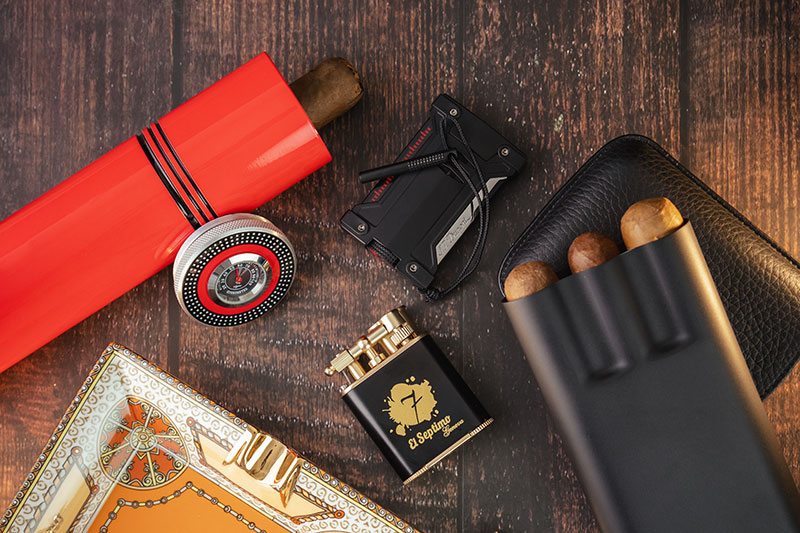
Ammezzato (ammed-zato)
Cutting a cigar in half rather than smoking stronger and longer cigars in their entirety at once, providing two smokes per cigar.
Example: Toscano cigars are ideal for casual enjoyment and can be shared among smoking pals, smoked ammezzato.
Box Press
Box-press cigars are squared off and flat in shape due to being tightly packed into a confined rectangular box. Many cigar aficionados prefer box-pressed cigars as they believe that this method provides a better construction, draw, and burn.
Example: Warped offers box-pressed cigars, which are squared off and flat, including the Corto cigar.
Broadleaf
This tobacco is grown in open sunlight and is considered to be one of the most prized wrapper leaves. It is often utilized in Maduro cigars.
Example: Connecticut Broadleaf is grown in areas of the Connecticut River Valley in Connecticut and Massachusetts.
Dual Wrap/Barber Pole Wrap
These wrappers are exactly as they sound: wrapping two different tobacco wrappers together as one, giving the appearance of a barber pole, or a candy cane, within the pattern both create on the surface of the cigar.
Example: Founder Cigar's Dual-Wrap cigar is a dual-wrap cut in a barber-pole style, combining a medium Ecuadorian Habano wrapper with Connecticut shade wrapper.
Hecho A Mano (eh-cho ah mah-noh)
Often featured on cigar boxes, this Spanish term translates to "made by hand." This term does not mean that the cigar was fully made by hand; the rolling is done by hand while manufacturers have employed machines to assist in bunching the filler.
Example: This cigar is "hecho a mano," or made by hand, and represents impressive craftsmanship in construction and quality of the smoke.
Totalmente A Mano (to-tal men-te ah mah-noh)
"Totalmente a Mano" means that the cigars were 100% handmade, from packing to rolling, with no machines utilized to assist assembly.
Example: All Cohiba cigars are 100% handmade, or totalmente a mano.
Humidity Pack
These control the humidity level inside of cigar packaging, keeping them stored at the optimal level (typically between 62-75%). A two-way system works together to absorb extra moisture when humidity rises, or releases moisture when it's too low.
Example: Boveda is a two-way humidity pack designed for humidors, available in five different RH levels (ranging from 62-75%) allowing you to choose and control your desired humidity level.
Humidor
The ideal place to store cigars for long-term aging and short-term readiness, humidors help keep them fresh. Designed with a tight seal to lock in humidity and maintain the preferred level, a humidor is also the word for the room in a cigar shop where cigars are stored.
Example: The humidor at Low Country Pipe and Cigar stores an array of cigars, ideal for aging for a long time and also for short-term freshness.
Hygrometer
This device measures the humidity level in a humidor. A variety of models are available, including analog and digital, providing temperature and humidity measurements.
Example: Utilizing a hygrometer ensures that your cigars are properly stored with the optimal humidity levels in your humidor.
Infused Cigars
These cigars are flavored with a particular flavor, bringing a unique element to the smoker.
Example: Tabak Especial from Drew Estate is an infused cigar that is flavored with coffee.
Sweet-Tip Cigars
Exactly as they sound, sweetened cigars, or sweet-tip cigars, refer to sticks with a sweet element greeting the smoker predominantly at the start of the smoke, dwindling to a more subtle sweetness as the smoke continues. Most of these cigars are mild, with the sweetened cap adding an accent to the flavor.
Example: Blind Man's Bluff Sweet Tip from Caldwell Cigars features mild flavor with a sweetened cap, affording the flavor of milk chocolate.
Pilón (pee-lohn)
A pile of tobacco leaves that are arranged in bulk batches during the fermentation process. Before fermentation, the tobacco is kept in a curing barn for around 5 days. Then, it's moved to a warehouse for fermentation; individual leaves are tied together in a "hand," and multiple hands are assembled in pilónes.
Example: The tobacco was arranged in pilónes during the fermentation process before being utilized in an array of cigars.
Primings
These are the vertical sections, or levels, of a tobacco plant, yielding leaves that are rolled into specific components of a cigar. A tobacco stalk has three parts utilized in cigar making: ligero (the top), seco (the middle), and volado (the bottom).
Example: Ligero primings are used in the La Flor Dominicana Double Ligero cigar, providing stunning construction and warm flavor notes.
Puro (pyur-oh)
The Spanish word for "cigar," puro typically refers to cigars made with tobaccos grown in one country.
Example: My Father Cigars' Flor de las Antillas line features Nicaraguan puros with full-bodied flavor.
Retrohale
A term utilized by cigar smokers to describe the process of expelling smoke through the nose. This method makes detecting the nuanced flavors and aromas easier to note throughout the smoking experience because the nose has receptors that can perceive experiences that the palate alone cannot.
Example: Through the retrohale, I am getting notes of cedar and espresso.
I hope this piece has aided in your understanding of cigars. Enjoy your smokes with these newfound terms under your belt!
Bibliography
- Editors, C. (2022, August 9). Cigar shapes, sizes and colors Cigar Aficionado.
- Holt's Cigar Company. (n.d.). Must-know cigar terms & lingo Holt's Clubhouse.






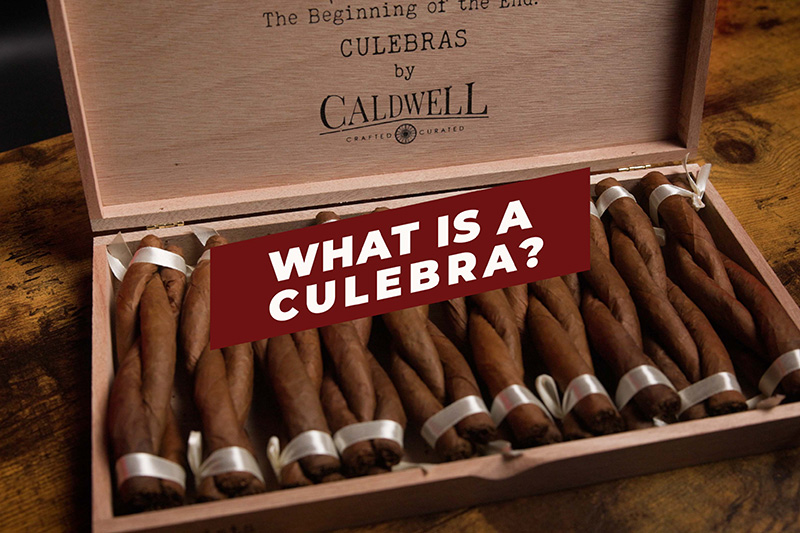



Comments
I had to stop reading at the color list. Maduro is NOT a color shade. It is a process.
Chris, thank you for catching that! It has been updated.